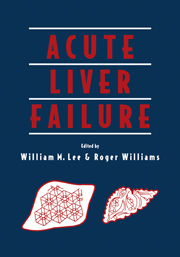Book contents
- Frontmatter
- Contents
- Preface
- Foreword
- Acknowledgments
- Contributors
- Part One Clinical Syndrome and Etiology
- 1 Classification and clinical syndromes of acute liver failure
- 2 Viral hepatitis and acute liver failure
- 3 Drug hepatoxicity as a cause of acute liver failure
- 4 Acetaminophen-induced acute liver failure
- 5 Unusual causes of acute liver failure
- 6 Pediatric aspects of acute liver failure
- Part Two Mechanisms of Disease and Multisystem Involvement
- Part Three Intensive Care Management
- Part Four Transplantation
- Part Five Artificial and Bioartificial Liver Devices
- Part Six Other Applications
- Index
- Plate section
1 - Classification and clinical syndromes of acute liver failure
from Part One - Clinical Syndrome and Etiology
Published online by Cambridge University Press: 20 May 2010
- Frontmatter
- Contents
- Preface
- Foreword
- Acknowledgments
- Contributors
- Part One Clinical Syndrome and Etiology
- 1 Classification and clinical syndromes of acute liver failure
- 2 Viral hepatitis and acute liver failure
- 3 Drug hepatoxicity as a cause of acute liver failure
- 4 Acetaminophen-induced acute liver failure
- 5 Unusual causes of acute liver failure
- 6 Pediatric aspects of acute liver failure
- Part Two Mechanisms of Disease and Multisystem Involvement
- Part Three Intensive Care Management
- Part Four Transplantation
- Part Five Artificial and Bioartificial Liver Devices
- Part Six Other Applications
- Index
- Plate section
Summary
INTRODUCTION
Acute liver failure (ALF) describes a constellation of clinical symptoms associated with sudden cessation of normal hepatic function (Hoofnagle et al. 1995). The denning state is hepatic encephalopathy and the development of a coagulopathy with subsequent jaundice. In many cases this clinical picture is associated with cerebral edema, renal impairment and multiorgan failure. All of these clinical features need not develop in every case and are not specific to the etiology of the ALF. Patterns may be discerned which can indicate the etiology, for example those with acetaminophen (paracetamol) overdose often present with encephalopathy and severe coagulopathy which may progress rapidly to cerebral edema although the patient may not be jaundiced, whereas patients with non-A non-B hepatitis more often present with deep jaundice but are less likely to develop cerebral edema. First described as acute yellow atrophy, acute liver failure has continued to challenge clinicians and, in spite of many advances, it still carries a significant mortality.
In 1946 Lucke and Mallory reported the rare occurrence of fatal hepatitis as a consequence of epidemic hepatitis (Lucke and Mallory 1946). They distinguished two clinical courses: fulminant, with a rapidly fatal outcome, and a subacute form with a slower course but equally poor prognosis. The first attempt at a formal definition was by Trey and Davidson in 1970, who described fulminant hepatic failure as “a potentially reversible condition, the consequence of severe liver injury, with the onset of hepatic encephalopathy within eight weeks of the first symptoms and in the absence of pre-existing liver disease” (Trey and Davidson 1970).
- Type
- Chapter
- Information
- Acute Liver Failure , pp. 1 - 9Publisher: Cambridge University PressPrint publication year: 1996



